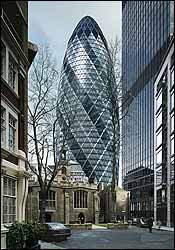
Even before 9/11 shattered New York’s skyline, Manhattan’s monopoly on the high-rise had been broken. In cities like Singapore, Hong Kong, Shanghai, Seoul, Tokyo, Beijing, Vienna, Berlin, Mexico City, London, and Frankfurt, innovative architects have been reinventing the skyscraper, rendering shapely symbols of their own world-class status. Unthinkably, even as it struggles to rebuild, New York is rapidly becoming out-towered.
MoMA’s latest exhibition, Tall Buildings, curated by the museum’s Terence Riley and New York engineer Guy Nordenson, dramatizes the globalization of the skyscraper. Some of the 25 groundbreaking towers on exhibit may have been proposed for New York (mainly to replace the Twin Towers), but the critical mass of these innovative buildings, with designs that find logic outside the girdle of the straitlaced structural tube, are offshore. Through a combination of chauvinism, provincialism, and hubris, we’ve gotten stuck in the notion that Manhattan’s conventional high-rises are, ipso facto, the best. But great height breeds replication and standardization: Developers bearing calculators turn designers into accountants. Despite all the rhetoric, the Freedom Tower—conceived by Daniel Libeskind, and later reworked by David Childs of Skidmore, Owings & Merrill, under developer Larry Silverstein—only demonstrates, depressingly, New York’s m.o. of compromise. Like the camel, it looks (and is) designed by committee.
“MoMA’s exhibition is a useful corrective, showing what might have been at ground zero.”
MoMA’s exhibition is a useful corrective, showing what might have been at ground zero. In London, Malaysian architect Ken Yeang rips apart the tube, creating two boomerang-shaped towers that wrap a landscaped elevator core, forming a virtual breathing apparatus—complete with public parks, semi-private entrance courts, and balconies interspersed among the apartment towers. For the London headquarters of Swiss Reinsurance, Lord Norman Foster has internalized the idea of an eco-tower with a series of atria that spiral up through the building, forming a continuously terraced green zone. Also in London, Italian architect Renzo Piano breaks open the normally closed body of the tower, with surface planes that pinwheel out from the body into turning facets. In Vienna, Hans Hollein horizontalizes the floors near the rooftop with projections daringly cantilevered into thin air.
This is gripping work, but perhaps the most frustrating exhibits are those of plans intended for Manhattan, never to come to fruition. For his proposed New York Times tower, Frank Gehry separated the skin from the structure by creating billowing walls of glass, housing interior gardens and courts. The most regrettable loss by far is the World Trade Center scheme by United Architects, beautifully represented here with a huge model, plus generative sketches. “Tall Buildings” would be a wild success even if United’s scheme were the only one shown. It’s a single design that develops a new paradigm for a tower of multiple footprints that twist in their upper reaches into Siamese relationships: The towers wrap around their cores, forming continuous floor plates large enough to make a small city organized along a Main Street in the sky. Its design driven by the logarithmic thinking of the computer, the building swells and morphs in continuous shapes that, by escaping obvious visual rationality, achieve the sense of wonder necessary to help cure the pain of this troubled site. This is the building that got away.
Though the curators have done due diligence in gathering a provocative list, they fall short as interpreters of their own material. For instance, the wall texts don’t analyze the growing presence of the computer, which is encouraging formal fluidity in architecture—including the spirals that emerge as a major theme among the buildings shown. Norman Foster’s entry for the World Trade competition revolves in mesmerizing twists, as does Santiago Calatrava’s “Turning Torso” in Malmö, Sweden, a mixed-use apartment-office tower.
Sadly, the 25 designs are left standing on their own, unrelated in any explanation by building type, evolution, or concept. Because the curators do not relate the buildings to each other in a larger context, the exhibition amounts to reportage without evaluation. Some of these buildings are more equal than others.